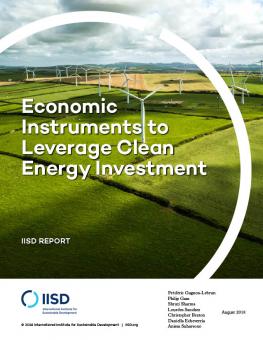
Economic Instruments to Leverage Clean Energy Investment
There is widespread recognition that the bulk of the investment needed to meet the Paris objectives and SDGs will have to come from private investors aiming to make commercial returns.
Many of the needed investments are not currently considered to be attractive private sector opportunities. How can those opportunities be made sufficiently attractive for private investors to dedicate their funds at the scale needed for the necessary energy transition? Answers to this question suggest a strong role for economic instruments capable of leveraging private investment.
This report focuses on specific fiscal policies in three major developing economies and discuss the extent to which they support—or detract from—Nationally Determined Contribution and SDG achievement, and the emerging energy transition:
- India – Goods and Services Tax (GST) reform
- Mexico – Renewable Energy Certificates (RECs) market
- Indonesia – Fossil fuel subsidy reforms
It finds that Indonesia, Mexico and India are all pursuing a shift to renewable and clean energy, in part to achieve their Paris climate targets. Their experience in introducing new economic instruments or in reforming existing ones highlights their critical importance in planning the achievement of NDCs and energy-related SDGs. On the one hand, they can impede renewable energy investment, a situation that calls for urgent reforms to better align the economic policy environment to the countries’ international commitments. On the other hand, the use of new economic instruments must be part of policy packages used to incentivize desirable private investments to drive the energy transition. Mexico’s case highlighted the use of a CEL market alongside other climate-focused policies to promote clean energy investment.
It concludes by submitting four broad recommendations to governments:
- Seek to align economic policies with NDC targets and energy-related SDGs.
- Ensure economic instruments, taken as a whole, send an overall signal to investors that is clear and strong enough to shift investments.
- Consider using public finance raised by economic instruments in a way that fosters the energy transition.
- Build an evidence base for the careful design of economic instruments and their ongoing assessment and adjustment.
You might also be interested in
November 2024 | Carbon Minefields Oil and Gas Exploration Monitor
In October 2024, 20 oil and gas exploration licences were awarded across three countries, with a significant portion granted by Brazil.
Coalition against fossil fuel subsidies expands but misses initial targets
The UK, Colombia, and New Zealand have signed on to a coalition of governments aiming to phase out fossil fuel subsidies, joining 13 other mainly European nations in the alliance. IISD's Vance Culbert said that half a dozen more countries—including "a few larger economy developing countries"—are talking privately to them about joining too.
Europe’s Dash for Gas in Africa puts Private Profits First
Europe’s demand for gas is contributing to expansion of LNG projects in Mozambique, Nigeria, and Senegal. This favours the interests of European oil and gas companies over those of African countries, a new report shows.
A Precarious Pursuit
BP, TotalEnergies, and Eni stand to profit from Europe's dash for gas in Africa, while host countries Mozambique, Nigeria, and Senegal take the risks.